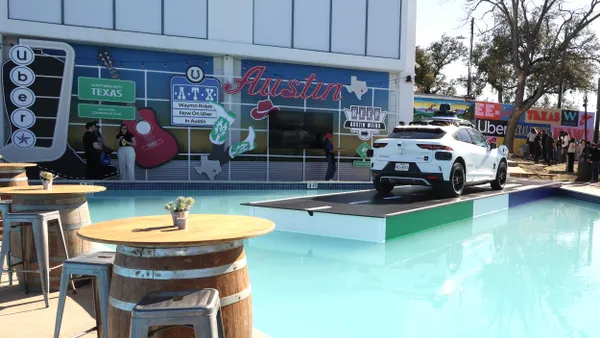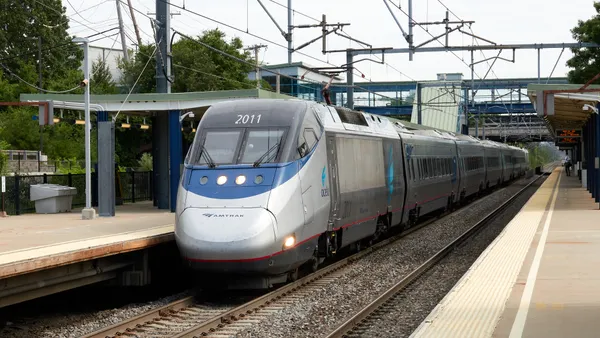The modern urban trip no longer centers around a single form of transportation. With a flurry of mobility options on the rise, more city residents and commuters experiment with customized combos of mobility modes to get from door to door.
"Transportation is really flattening out to shorter trips throughout the day. It's upending transportation planning and how people are getting around. I think if we see this trend continue, we're going to see more of an outcry for mobility as a service (MaaS)," Sarah Kaufman, associate director of the New York University Rudin Center for Transportation, told Smart Cities Dive.
Different transportation modes — public transit, bike-share, e-scooters, ride-hailing, taxis — tend to require separate modes of payment. Therefore the concept of combining them all into a single MaaS platform where users can plan and pay for multimodal trips is creating buzz.
Despite interest in single MaaS platforms, only a handful of true MaaS applications are available, which raises a pressing question: Why is execution so slow?
Existing MaaS platforms
Private companies such as Uber and Lyft have been key players in the movement toward mobility integration by offering ride-hailing, bike-share and e-scooters through their apps. Both are now adding real-time transit information to their apps in select cities, and customers in Denver can even pay for transit fare through the Uber app.
Now, some U.S. transit agencies are working to develop their own MaaS platforms, though many have not yet gone public. In May, Louisville, KY’s Transit Authority of River City (TARC) became one of the first domestic transit agencies to release a nearly complete MaaS platform.
“We're transforming who we are as a company, going from being a service provider to a multi-solution provider,” Max Maxwell, TARC director of marketing, told Smart Cities Dive. "We wanted to create something we owned, that we can develop, that we could really make fit."
TARC launched its platform with the help of developer ZED Digital. It integrates transit, ride-hailing, bike-share and e-scooters so customers can plan real-time, multimodal trips. The app hasn’t yet added a key component of a complete and comprehensive MaaS platform — the capability to fully pay for all transportation modes — but that’s expected later this year.
“We think the convenience is going to be a driver. In today’s world everyone is looking for convenience,” Maxwell said. “This is something we're being intentional about. We think this is the wave of the future.”
Full MaaS platform development "happens incrementally," said Art Guzzetti, vice president of policy and mobility at the American Public Transportation Association (APTA). "You start with real-time multimodal trip planning, that's one of the first building blocks, and then you go to payment systems and eventually some [agencies] are going to subscription services," in which the separate services are sold for a bundled price.
But even without multimodal integration in place, "mobile ticketing is very important" for transit agencies to explore and eventually can open the door to a full-blown MaaS platform, Guzzetti said. He points to transit agencies in Dallas; New York; Portland, OR; Phoenix; Ithaca, NY; and Chicago as forward-thinking in either mobile payments or multimodal integration, positioning them as front-runners for releasing complete MaaS platforms domestically.
European transit agencies are a bit farther ahead in their MaaS platform development. Guzzetti pointed to Vienna, Austria; Hamburg, Germany; and Helsinki, Finland as leaders in the space.
Helsinki is also the home of private developer MaaS Global, whose Whim app is heralded as one of the first complete MaaS platforms to hit the global marketplace. Like others apps, Whim offers multimodal trip planning, and users can pay on a trip-by-trip basis or through subscription services.
"There has to be a balance. There have to be different types of services so we can actually cover 100% of your mobility needs," Krista Huhtala-Jenks, MaaS Global head of ecosystem and sustainability, told Smart Cities Dive. "We’re competing against car ownership. In order to compete against car ownership, you need to bring to the table something pretty spectacular."
MaaS Global welcomes competition, including from public transit agencies, because that gives customers the most choice. "In the end the customers will be the ones losing out if you don't have more choices than just one," Huhtala-Jenks said.
"We’re competing against car ownership. In order to compete against car ownership, you need to bring to the table something pretty spectacular."

Krista Huhtala-Jenks
Head of ecosystem and sustainability, MaaS Global
She stresses that all competition must be "on a level playing field." For example, transit agencies that develop their own MaaS platforms would have an unfair advantage if they chose to withhold transit information from competitors’ integrated apps.
One benefit for cities or transit agencies relying on a private company’s app instead of building their own is conserving the use of taxpayer-funded resources.
But Huhtala-Jenks said betting heavily on one platform is risky. "This kind of development is so fast-paced at the moment that there’s no guarantee what solutions will be the surviving ones and how quickly that will change."
What’s the holdup?
MaaS platforms are complicated to develop and often private companies have better expertise than public entities to get them up and running.
"I think the primary reason that private companies do it and cities don't is private companies have the resources and workforce skills for technology like this. It involves a lot of integration and workforce development. And some private companies will not agree to be in the same app or menu of selection with competitors," NYU’s Kaufman said.
MaaS Global’s experience corroborates the latter challenge.
"It takes a willingness to work together [by] the different organizations,” Huhtala-Jenks said. “The challenge this raises is… having this open ecosystem where everybody works together competing against car ownership, and not, for example, trying to hold onto the businesses, which are built on small margins.”
In many cases, large cities have more resources than small or mid-sized cities, but they also have more infrastructure-related complexities. For example, big cities tend to have more area to cover, more transit options, more privately-run modes of mobility and more street-level and bureaucratic distractions that must be considered.
Louisville might have been the first to roll out a MaaS platform not just because of its forward thinking leaders, but also because “it's a less complex environment. It would make sense in Louisville, which probably doesn't have the same number of complicating factors that New York or L.A. does,” Kaufman said.
New York, she said, has "too many silos of control that would take a real master plan to integrate. It would take leadership at very high levels to enforce this kind of coordination."
But even for private companies, it’s no easy task.
"You need to have deep integration where you have booking, routing and paying [to be] very, very seamless," Huhtala-Jenks said. "Different service providers don't necessarily have all of the APIs ready. They also might have the APIs but they’re not complete with functionality."
Aggregating payments for multiple agencies and service providers in one place also complicates the billing process.
"[When] all payments for all the different options are coming to a single place, you need to figure out who gets what. What's the share that goes to transit? What share goes to bike-share? What share goes to taxi?" Guzzetti said.
So why do it?
Despite the challenges, customer convenience is a key reward.
Ultimately, transit agencies can benefit from increased customer satisfaction if that leads to an increase in ridership. That’s one of the ancillary benefits TARC is banking on once its app reaches full potential with integrated payments and subscriptions.
Transit agencies also can benefit from gaining access to more mobility data via an in-house MaaS platform.
"We strongly believe we should always share data," MaaS Global’s Huhtala-Jenks said. "Cities definitely should be demanding it from all the different partners so they can develop different kinds of outcomes and result-based tools."
Industry participants agree that many forward-thinking domestic transit agencies will do their best to launch MaaS platforms in the coming months and years. "If not, the private sector may just leapfrog over their efforts," Kaufman said.
But Guzzetti's confidence remains in public transit agencies.
“It will be crowded on the way, and there will be multiple Mobility as a Service platforms ... but in the end the transit agencies have a strong case to make that they're the best players in this role," he said.










